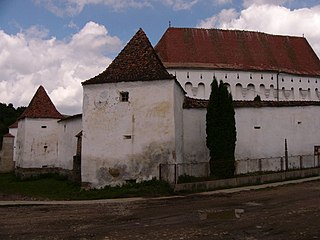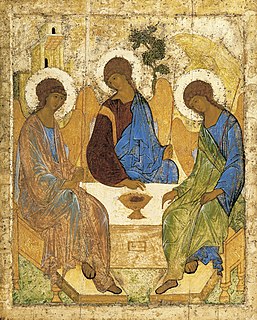 W
WThe Annunciation Triptych is a tempera on panel painting by the Italian late Gothic artist Lorenzo Monaco, now housed in the Gallerie dell'Accademia in Florence, Italy.
 W
WChrist the Redeemer is an icon discovered by accident in a dilapidated woodshed near Zvenigorod in 1919. With several other icons stored nearby, it was attributed as the work of the great Andrei Rublev, painted for one of Zvenigorod cathedrals in the 1420s. It is exhibited in the Tretyakov Gallery of Moscow.
 W
WThe Dârjiu fortified church is a Unitarian fortified church in Dârjiu (Székelyderzs), Harghita County, in the Transylvania region of Romania. It was built by the Székely Hungarian community at a time when the area belonged to the Kingdom of Hungary. Initially Roman Catholic, it became Unitarian following the Reformation. The church is noted for its interior frescoes, and together with the surrounding village, forms part of the villages with fortified churches in Transylvania UNESCO World Heritage Site.
 W
WThe Davis Madonna is a c.1410 tempera on panel painting by Gentile da Fabriano, now in the Metropolitan Museum of Art in New York. It is named after Theodore M. Davis who acquired it in Florence early in the 20th century before leaving it to its present owner in 1915.
 W
WThe Gothic altarpiece of Santes Creus is an altarpiece painted by Guerau Gener and Lluís Borrassà between 1407 and 1411. It is one of the key works of the International Gothic altarpieces in Catalonia, created for the Santes Creus Monastery. The MNAC museum retains the Nativity, crowned by the figure of St. John the Evangelist, and the Resurrection of Christ, while the rest of the tables are kept in one of the chapels of the cathedral of Tarragona. The altarpiece was commissioned to Pere Serra but apparently died without starting it. Guerau Gener, a connoisseur of València international Gothic, replaced him, but his untimely death made Lluís Borrassà, one of the major figures in the painting of the first international Catalan Gothic, to complete the project.
 W
WMadonna and Child Enthroned with Two Angels is a c.1410-1415 tempera and gold on panel painting by Gentile da Fabriano. Its original provenance is unknown, though its small size probably means it was made for private devotion. It is first recorded in the early 20th century, when it was in the Casa Persicini in Belluno, which suggests it links to the painter's time in Venice. It is now in the Philbrook Art Center in Tulsa, Oklahoma.
 W
WThe Paradiesgärtlein is a panel painting created around 1410 by an unknown painter referred to as Upper Rhenish Master. It belongs to the Mary in the rose bower type. The Paradiesgärtlein is one of the earliest paintings to naturalistically depict flora and fauna
 W
WProfile Portrait of a Lady is oil on panel painting by an unknown Franco-Flemish artist, dated to about 1410. It is housed in the National Gallery of Art, Washington.
 W
WSaint Augustine and Alypius Receiving Ponticianus is a 1414–1415 painting by Nicolò di Pietro, which has been in the collection of the Musée des Beaux-Arts de Lyon since 2009.
 W
WThe Trinity is an icon created by Russian painter Andrei Rublev in the 15th century. It is his most famous work and the most famous of all Russian icons, and it is regarded as one of the highest achievements of Russian art. Scholars believe that it is one of only two works of art that can be attributed to Rublev with any sort of certainty.
 W
WThe Valle Romita Polyptych is a painting by the Italian late Gothic painter Gentile da Fabriano, dating from c. 1410-1412 and now housed in the Pinacoteca di Brera in Milan. It was originally executed for the Franciscan hermitage of Valle Romita near Gentile's birthplace, Fabriano.